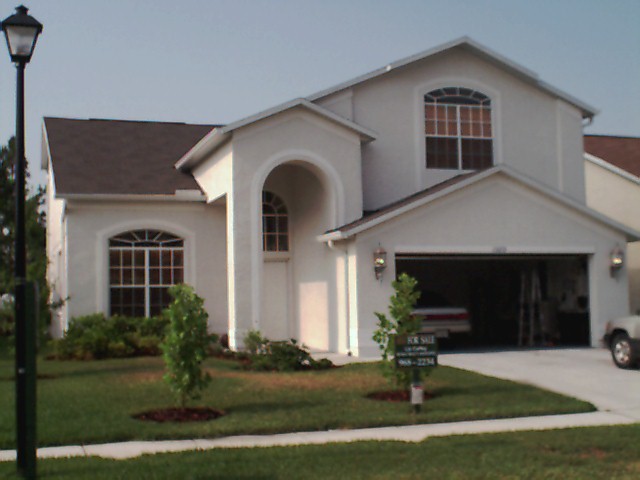
This will be a two-part article on my experiments with stealth and portable vertical antennas. This first part will address three temporary experiments (really two and a modification), which may (or may not) offer some useful information for those interested in portable operation. You won’t find much science here except in the references to good sources. The second part will be my attempt to implement and document Diz’s, FP-1, W8DIZ idea for a "permanent" all band vertical at my particular location with all of its limitations (and alligators), which is evolving into quite a project! This link will give a hint regarding my other idea: (Curtains for the swamp!).
"In the mean time..."Many of you reading this already know, but for background I’ll say that I recently moved from a wonderful location where I enjoyed extraordinary performance from stealth antennas. The 70’ long attic running north/south housed the I.A.D. (Infamous Attic Dipole)1 which evolved into a twinlead fed multiband G5RV variant. That antenna genuinely spoiled me, performing way beyond expectations for an indoor antenna. Further, multiple huge Live Oak trees surrounded my house and eventually supported a 280’+ stealth loop which seemed to rake in DX contacts despite the fact that I was the operator! These two antennas worked well in concert, swapping back and forth with varying conditions and propagation. I was a happy piggie. Then, prompted by job related issues, I moved, again into a deed restricted development selected by SWMBO (she who must be obeyed). Sigh.
The Negatives
The new location has a very active CEC (Covenant Enforcement Committee), whose secretary happens to live next door to me. Sigh. The new house is two story, with no attic at all, and houses are very close on each side (NE and SW). I have tried a loaded flagpole antenna in the front, various wires on my roof, an under-the-eave dipole, loading up the rain gutters, and even a "droopy loop"2 idea around the circumference of my roof, all with unsatisfactory results. To put this in perspective, I chatted with Dennis, KA8TQR in Parma, OH, for about 15 minutes. Dennis was using a Rock Mite and a dipole with my K2 at 3 watts and a 40m Hamstick stuck out the window! Most of us have experienced those wonderful odd contacts. Weird things do happen, but one can’t depend on that kind of propagation consistently. The house’s backside and backyard remain my only potential options for antennas. Unfortunately, the back not only faces southeast (you think YOU notice the 40m SSB on 7.044 MHz?), but also slopes downward away from the two story house toward the swamp making takeoff angles toward any direction but southeast an issue.
I planted some trees around the circumference of my little, cramped lot (future loop!), but they are not tall, 6’-15’ at best. All the good trees, 40’+ in height, are across the swamp/canal, by the lake, and are not on my property. While there are some small trees along the swamp (less than 15’ tall) various feedlines have been cut by grounds and maintenance crews who come along sporadically. The one good potential tree (a 30’ pine) is 6" (INCHES!) across the property line on my neighbor’s lot. (Disclaimer: Yes, it’s Madam Secretary’s side, and Jo, FP-325, K5HOY says I shouldn’t even consider using that tree, citing various applicable sins. Sigh, Jo is right of course, but she is such a GIRL! Diz, by the way, didn’t even ask about the property line - grin.) The covenant rules prohibit boats in the swamp, canal and lake, which brings up one other issue that could be seen as negative relative to any work done by the water: gators.

My "shack" is in the middle room of the second floor (the office) and I have a painted PVC feedline pass-through that is almost invisible down to the ground. It contains both RG58 coax and 300ohm twinlead, thus the issue of getting the feedline down and out of sight is resolved. The soil, while somewhat sandy (it IS Florida), stays pretty damp, and the slope down to the water lets the feedline PVC drain, plus, the dampness helps with ground plane issues. (This moisture may have also contributed to my positive experience at old location which was 2/3 surrounded by lake.) The afore mentioned row of scrub trees and small pines along the edge of the swamp, which currently supports the short side of my broken Windom, are there and useable such as they are. Plus, the Homeowner’s Association no longer sends the guys with weedeaters along the edge of the swamp, so my feedlines are somewhat safer. Last but not least, SWMBO doesn’t care what I do back there antennawise as long as she doesn’t have to come and look at it and pretend she is impressed with my work.
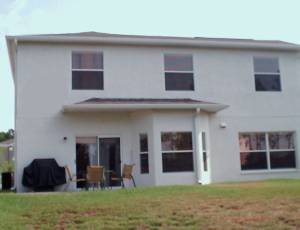
This is a picture of the back of the pre-deck house. I’m pleased to say you cannot see the feedline/PVC coming down from the middle window to the ground. (Even if the picture was focused!) The swamp is behind you in this view.
Primarily because of the lack of natural antenna supports, I decided to experiment with verticals. This was both encouraged and daunted by reading some of the work of antenna greats like Moxon, G6XN, Ceibik, W4RNL and Maxwell, W2DU - (whew!). Seminary did very little to prepare me for all this theory stuff, but of particular interest was Moxon’s conclusion that verticals properly erected with their "feet on the ground" work nearly as well as when raised in the air.3
Experiment #1 - The St. Louis Vertical, original version.The original article4 and instructions for NF0R Dave Gauding’s design are found at: St. Louis Vertical (1), or St. Louis Vertical (2)
There are several "upgrades" offered for this antenna, some commercial and others homebrew. I wanted to keep it simple and stealth, maintaining the advantage of quick setup and take-down.
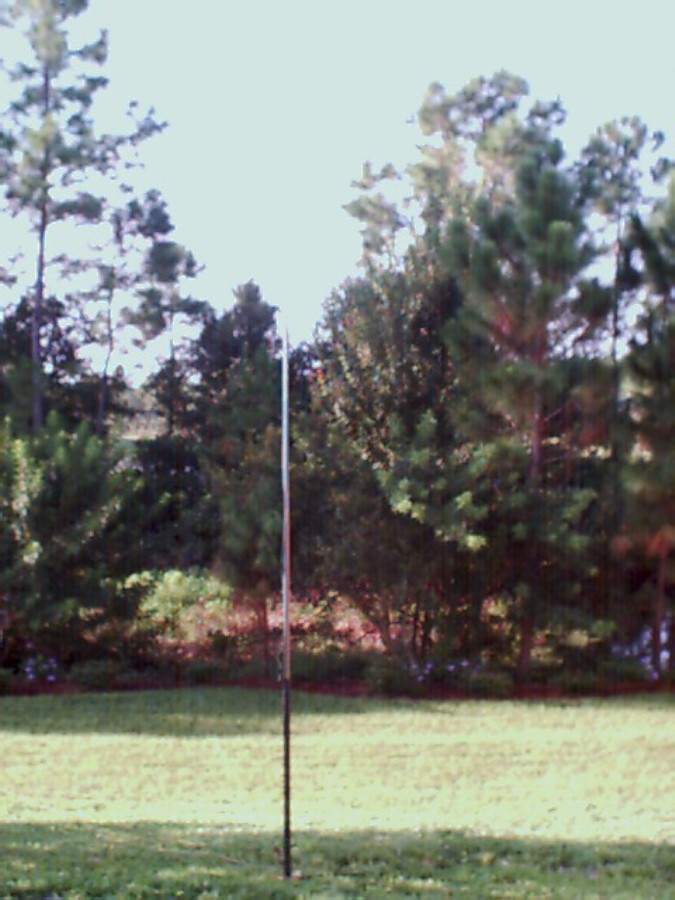
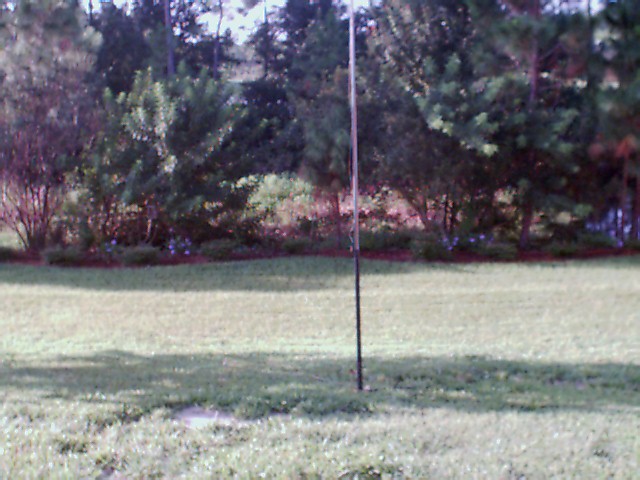
Here is a couple of pics looking out to my backyard with the infamous swamp/lake in the background. (Notice those wonderful inaccessible trees just across the water, that will one-day support my stealth loop! This will happen when those lazy "pigs" Paul FP-124 K4FB, Brian FP-57 KB9BVN, Mikey FP-68 WB8ICN, and Aron FP-122 NN1F get off their duffs and visit me like Diz did!) At night this antenna is very hard to see.
This version uses 300ohm twinlead wrapped tightly around the base of the SD-20 fishing pole as the "coil". Dave’s idea was to add 46’ of coil wire to extend the 20’ radiator to an approximate 1/2 wave on 40m, full wave on 20m, etc. My heavy duty twinlead would not fit that many turns on the base section of the pole. No worry, because several builders reported having to shorten the coil wire to bring the antenna to resonance above 7 MHz. (This is covered in an appendix to Dave’s article on the NorCal website.) According to my MFJ 259b analyzer, my 100 turns resonated at 7.023 MHz with the addition of four approximate 25’ radials. I don’t worry so much about resonance on 40m because I like to operate multiband and use a tuner. Subsequent homebrew versions of the antenna use shorter coil of bigger diameter with wire formed around PVC or cardboard. One may then use an alligator clip to tap the coil for different bands.
At "home" I have been using 8 radials of random different length (between 15’ and 25’) fanning out relatively equidistant from the base. The radials attach to one side of the 300ohm twinlead via alligator clips. That close to the swamp, I HAD to use alligator clips.
It’s fed with 300ohm twinlead which runs from the base of the antenna up to the back of the house. There it finds the painted PVC pipe up to and through the second floor window of the shack and the internal ATU of the K2 or the Emtech ZM-2 when I am on the MP#4 (old ugly version) or various other QRP mono-banders.
On the trail is where it really shines. I use it in the ARS Spartan Sprints, and "To the Field" events like FYBO and BYBO. The SLV’s SD-20 fiberglass pole collapses down to about 4’ and I use it as a walking stick. The feedline, radials and guys all fit an a small zip-lock bag which fits in the same compartment of my backpack as the rig (usually the Norcal 20 or the Small Wonder Labs 40, sometimes the K2). The vertical requires no launching wire into trees - something that became somewhat important to me when I ripped the rotator cuff in my throwing shoulder! Further, launchers of various sorts are added weight and hassle. No external support is required, with the possible exception of guys in very windy conditions.
I found my implementation of this renowned, simple, portable to work well, amazingly well, in fact, especially as a backpacking/trail antenna. It is easy to build and really works well multiband if you use a twinline feed and tuner. But down in the valley at home I was not getting the performance of NF0R! Each time I hear Dave on the air I call him to give him a report from FL and to thank him for the antenna idea. Earlier last year I had Dave’s signal (from MO) 579 when he used the St. Louis Express, and 589 or better on his St. Louis Vertical, which I believe is mounted on his roof. I need to ask him about his radial system, because comparatively, I’m not getting that kind of signal reports. Remember, mine is mounted downhill, with only 8 (sometimes 4 if I’m in a hurry) radials, and the low take-off angle is blocked to the west by houses. I can work EU fine, but this set-up at home was not helpful in the stateside foxhunts AT ALL. On the trail, as mentioned above, it works as good as any of my random wire or hasty dipole efforts.
I alluded to the added benefit that the SLV collapses down into a very portable 4’ section which I use as a walking stick when backpacking. But even a walking stick or the addition of a shoulder sling can be cumbersome when the trail involves climbs. Along came experiment number two.
Experiment #2 - The PAC-12, AF4PS Semi-dog-leg VersionJames Bennett KA5DVS, designed the PAC-12 and you can find a copy of the original article5 online at: http://www.njqrp.org/pac-12/. "PAC" stands for Portable Antenna Concept, and the "12" refers to the disassembled length. I was drawn to the PAC-12 for two reasons: 1) PORTABILITY (it really does break down into 12" sections) and, 2) PERFORMANCE, it won the HF-PACK6 portable antenna shootout.
The PAC-12 is a bit more complicated to build than the St. Louis Vertical, you will need access to a tap and die set. There are three tricky steps: If you are not experienced with these tools, you will end up with crooked threads like my semi-dog-leg version! (Mikey FP-68, WB8ICN subsequently told me about drilling a hole in a 2x4 to make a guide as one threads. I always get good advice like this AFTER I finish a project! Some tap and die kits come with a fancy clamp on guide also. Mine was found at a flea market, with no fancy guide included.) Drilling a small hole, tapping threads in the 5/16 hardened coupler and drilling out a portion of the original threads to receive and secure the telescoping whip base was not easy for me. If I didn’t have access to a drill press, I would have skipped that step, and forced the whip base into the coupler’s threads (not recommended). Also, a drill press makes drilling the hole in the PVC caps much easier, especially if you get the caps at Home Depot where I was told they will no longer be stocking the brand with a flat top. The new ones are beveled.

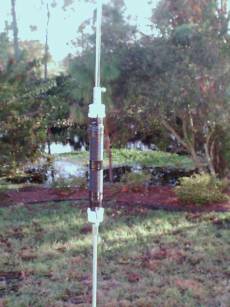
Above, you will see the components of the PAC-12, 2 threaded 12" rods, couplers, feed point (BNC connector on aluminum flat bar to which radials are attached), 72" telescoping whip with coupler, and two coils, 40m and 17m. In the swamp I use a 24" base section to push down into the sand. The second picture captures the 40m coil in action in my backyard with the swamp in the background.
I tried using a piece of copperclad for the feedpoint in my first effort. It worked great, but the copperclad seemed to oxidize, tarnish and gunk up pretty fast when exposed to inevitable moisture of my backyard and trail excursions. My second version uses the called for piece of aluminum flat bar, and I added connectors for my twinlead, as well as a BNC connector for coax.
The Next Level - Adding Permanence and Performance.Both of these antenna designs are wonderful as portable trail antennas. They also work well from my backyard as my "main" antennas. But I wanted to optimize their performance and make a more permanent setup for home, while maintaining my stealth profile.
I found an enlightening old article by Jerry Sevick, W2FMI from QST July 1971, regarding radials.7 (I read this while procrastinating finishing the back deck and considering if I might avoid re-soding the back lawn down to the swamp.) Sevick experimented with a 20m vertical to gauge the effect of adding radials. He concluded that significant improvement was experienced by adding up to 40 radials, with lessened, but still improvement gained by adding even more. He used 8 bundles of 5 wires attached to the base of the vertical, then fanned each bundle out symmetrically totaling 40. I had used random length radials, and radials cut for different bands before, but never in this number. Some of you will recall Doug Hendricks, FP-23, KI6DS from NorCal QRP Club and others have done this "bundle approach" using multi-stranded "computer ribbon" for their portable antennas. This bundling makes travel, set-up and take down MUCH faster and easier, with some trade-off of performance. However for a permanent installation, Sevick’s experiments demonstrated that more is better when it comes to radials, especially up to 40 of them. Further, many sources indicate that the length of buried or on ground radials is not as critical as with elevated radials. But Sevick demonstrated the contrary, that longer radials (25’) seemed to perform better than short ones, even on the ground. Also, he suggested if they are to be buried, bury them shallow (less than a few feet) as opposed to deep (over 6 feet), eventually recommending "slightly below the surface is the best way."
It occurred to me that I could lay down this huge (to me) array of 40 radials, then lay the new sod on top of them, and they would be buried an effective 4-6 inches, (unseen and out of lawnmower range) permanently deployed! I could possibly cut each of the five wires in each bundle at random length or Ľ wave for 5 different bands and see which worked better. I could use a recessed metal pipe as a base support for a vertical like the SLV or PAC-12. The radiator part could be removed when not in use. In addition, I only have to worry about the guy lines as opposed to stringing out a limited number of radials each time. WIGGII! (Ok, this work is still in progress, so the comparative results will be shared in part two.)

I’ve begun laying some of the radials which fan out partially under the not-so-finished deck. After the deck is done, I will start the preparation for the new sod, and deploy the rest of my wire. Boy, do I hate shoveling sand!
Part two will address an even more permanent solution to my antenna situation. Diz, FP-1, W8DIZ recently visited me because he was tired of hearing me whine about my antennas. He gave me an idea of a multi-band vertical permanently installed utilizing a (hypothetical) pine tree. I will also illustrate an alternative idea using the smaller trees along the edge of the swamp. In the mean time, I am working to maximize the performance of what I have. OO
If you want to learn the basics about antennas, go here: Jim Duffey "Dr. Megacycle" - KK6MC
If you REALLY want to learn about antennas, go here: L.B Ceibik - W4RNL
Here is a WONDERFUL source for portable (and other kinds) antlers (thanks to Mike W9WIS!) USMC FIELD ANTENNA MANUAL
If you feel sentimental and nostalgic, go here: The AF4PS Infamous Attic Dipole.